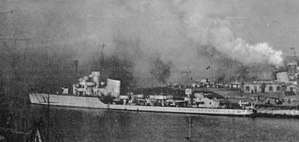Italian destroyer Aviere (1937)
 Aviere in Messina in 1941 | |
| History | |
|---|---|
| Name: | Aviere |
| Builder: | Odero Terni Orlando, Livorno |
| Laid down: | 16 January 1937 |
| Launched: | 19 September 1937 |
| Completed: | 31 August 1938 |
| Fate: | Sunk by torpedo, 17 December 1942 |
| General characteristics | |
| Class and type: | Soldati-class destroyer |
| Displacement: |
|
| Length: |
|
| Beam: | 10.15 m (33 ft 4 in) |
| Draught: | 3.15 m (10 ft 4 in) |
| Installed power: | 48,000 shp (35,800 kW) |
| Propulsion: |
|
| Speed: | 38 knots (70 km/h; 44 mph) |
| Range: | 2,200 nmi (4,100 km) at 20 knots (37 km/h; 23 mph) |
| Complement: | 206 |
| Armament: |
|
| Service record | |
| Part of: | Destroyer Division 11 |
| Operations: | |
Aviere ("Airman") was one of seventeen Soldati-class destroyers, built for the Italian Royal Navy (Regia Marina) in the late 1930s and early 1940s.
Construction and career
Aviere, built at the OTO shipyard in Livorno, was laid down on 16 January 1937, launched on 19 September 1937 and completed on 31 August 1938.[1]
World War II
When Italy entered World War II, on 10 June 1940, Aviere was part of the 11th Destroyer Division, together with sister ships Artigliere, Geniere and Camicia Nera.[1] On 11 June Aviere and her sister ships carried out a reconnaissance mission in the Sicilian Channel, and on 19 June they carried supplies from Augusta to Benghazi, Libya.[2][1]
On 9 July 1940 Aviere and her division participated in the Battle of Calabria; in the final phase of the battle the 11th Destroyer Division was ordered to attack the Mediterranean Fleet with torpedoes and did so (overall, ten torpedoes were launched), but scored no hits.[3][1]
On 11-12 October 1940 Aviere participated in the Battle of Cape Passero, where she was seriously damaged by gunfire from HMS Ajax.[4][1] Between March and September 1941 she escorted a number of convoys with troops and supplies from Italy to Libya; on 23 September 1941 she took part in a minelaying operation, escorting sister ships Lanciere, Carabiniere, Ascari and Corazziere that laid a minefield south of Malta.[5][6][7][8][9][10][11][1]
On 21 November and 13 December 1941 Aviere participated in two large convoy operations between Italy and Libya, which failed due to heavy attacks by aircraft and submarines; in both instances, she was detached to escort back to base damaged warships of the heavy cover groups (heavy cruiser Trieste, that had been torpedoed by HMS Utmost on 21 November, and battleship Vittorio Veneto, torpedoed by HMS Urge, on 13 December).[12][1] On 16 December Aviere took part in another large convoy operation to Libya, which was successful, and participated in the First Battle of Sirte.[13][14][1]
Between January and March 1942 Aviere participated in the escorts of four more large convoy operations to Libya, "M. 43", "T. 18", "K. 7" and "V. 5", that were successful.[15][1] On 21-22 March she took part in the Second Battle of Sirte, and on 11-12 August she participated in Operation Pedestal, where she towed the damaged heavy cruiser Bolzano, torpedoed by HMS Unbroken, to the island of Panarea.[16][1]
Between September and December 1942 Aviere carried out a number of escort and transport missions between Italy and North Africa.[1] On 16 December 1942 she sailed from Naples together with sister ship Camicia Nera, escorting the German freighter Ankara towards Bizerta; at 11:15 on the following day, the submarine HMS Splendid attacked the convoy and torpedoed Aviere, which blew up, broke in two and quickly sank in 38°00' N, 10°05' E. About one hundred of Aviere's 250 crew survived the initial sinking, but only 30 could be eventually rescued by the torpedo boats Calliope and Perseo on that afternoon, the rest having perished. 220 men were lost, among them the commanding officer of Aviere and DesDiv 11, Captain Ignazio Castrogiovanni, who was posthumously awarded the Gold Medal of Military Valor.[17][18][1][19]
References
- 1 2 3 4 5 6 7 8 9 10 11 12 "Aviere". conlapelleappesaaunchiodo.blogspot.it.
- ↑ "English Channel sea battles, June 1940". www.naval-history.net.
- ↑ "Battle of Britain July 1940". www.naval-history.net.
- ↑ Gianni Rocca, Fucilate gli ammiragli. La tragedia della Marina italiana nella seconda guerra mondiale, pp. 48-49
- ↑ "Royal Navy, World War 2, March 1941". www.naval-history.net.
- ↑ "Battle for Greece,Action off Sfax, April 1941". www.naval-history.net.
- ↑ "Capture of U.110 and German Enigma, May 1941". www.naval-history.net.
- ↑ "Inshore Squadron, Tobruk, June 1941". www.naval-history.net.
- ↑ "Attack on HX.133, June 1941". www.naval-history.net.
- ↑ "Malta Convoy, Operation "Style", August 1941". www.naval-history.net.
- ↑ "Malta Convoy "Halberd", September 1941". www.naval-history.net.
- ↑ "KMS Kormoran and HMAS Sydney, KMS Atlantis and HMS Dunedin lost, November 1941". www.naval-history.net.
- ↑ "Battle of Convoy HG76, loss of HMS Audacity, December1941". www.naval-history.net.
- ↑ "Action off Cape Bon, December 1941". www.naval-history.net.
- ↑ "Battle of the Atlantic, January 1942". www.naval-history.net.
- ↑ Gianni Rocca, Fucilate gli ammiragli. La tragedia della Marina italiana nella seconda guerra mondiale, p. 233-234
- ↑ Gianni Rocca, Fucilate gli ammiragli. La tragedia della Marina italiana nella seconda guerra mondiale, p. 272
- ↑ "HMS Splendid (P 228) of the Royal Navy - British Submarine of the S class - Allied Warships of WWII - uboat.net". uboat.net.
- ↑ "Ignazio Castrogiovanni - Marina Militare". www.marina.difesa.it.